4.4: Applications
- Page ID
- 37227
In the previous sections on applications, we saw situations in which right triangle trigonometry was used to find distances and angles. In this section, we will use the Law of sines and the Law of cosines to find distances and angles.
Example \(\PageIndex{1}\)
A car travels along a straight road, heading west for 1 hour, then traveling on another straight road northwest for a half hour. If the speed of the car was a constant 50 mph how far is the car from its starting point?
Solution
First, let's draw a diagram:

In the picture above, we know the angles \(45^{\circ}\) and \(135^{\circ}\) because of the direction the car was traveling. The direction northwest cuts exactly halfway between north and west creating a \(45^{\circ}\) angle. On the other side of this \(45^{\circ}\) angle is a \(135^{\circ}\) angle which is in the triangle we'll use to answer the question (triangle \(A B C\) ).
The length of \(\overline{A B}\) is 50 miles and the length of \(\overline{B C}\) is 25 miles. This comes from the information about the speed and traveling time given in the problem. So the triangle we need to answer the question is pictured below:

We can use the Law of cosines to solve this problem:
\[
\begin{array}{c}
b^{2}=a^{2}+c^{2}-2 a c \cos B \\
b^{2}=25^{2}+50^{2}-2 * 25 * 50 * \cos 135^{\circ} \\
b^{2} \approx 625+2500-2500 *(-0.7071) \\
b^{2} \approx 3125+1767.75 \\
b^{2} \approx 4892.75 \\
b \approx 69.9 \mathrm{miles}
\end{array}
\]
Example \(\PageIndex{2}\)
A pilot flies an airplane in a straight path for 2.5 hours and then makes a course correction, heading \(10^{\circ}\) to the left of the original course. The pilot then flies in this direction for 1 hour. If the speed of the plane is a constant \(350 \mathrm{mph}\), how far is the plane from its starting position?
Solution
Again, we'll start by making a diagram:

In this problem, we'll be working with triangle \(A B C\), shown below. We can calculate the lengths of \(\overline{A B}\) and \(\overline{B C}\) from the information given in the problem and use this to calculate the length of \(\overline{A C}\) :
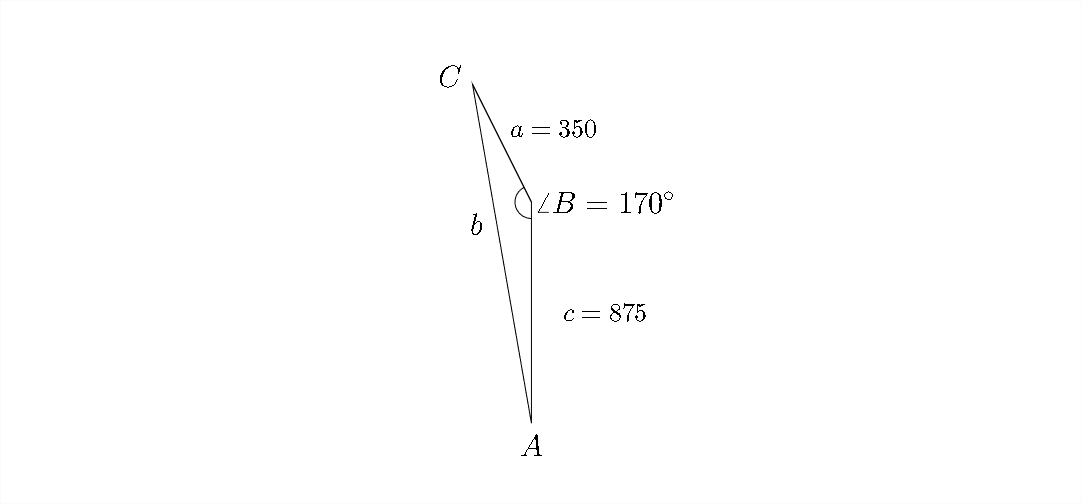
Using the Law of cosines:
\[
\begin{array}{c}
b^{2}=a^{2}+c^{2}-2 a c \cos B \\
b^{2}=350^{2}+875^{2}-2 * 350 * 1050 * \cos 170^{\circ} \\
b^{2} \approx 122,500+765,625-735,000 *(-0.9848) \\
b^{2} \approx 888,125+723,828 \\
b^{2} \approx 1,611,953 \\
b \approx 1270 \mathrm{miles}
\end{array}
\]
Example \(\PageIndex{3}\)
A pilot leaves the airport in Bend, headed towards Corvallis with the bearing \(N 70^{\circ} W .\) He travels the 103 miles and makes a delivery before taking off and flying at a bearing of \(N 25^{\circ} E\) for 72 miles to arrive in Portland.
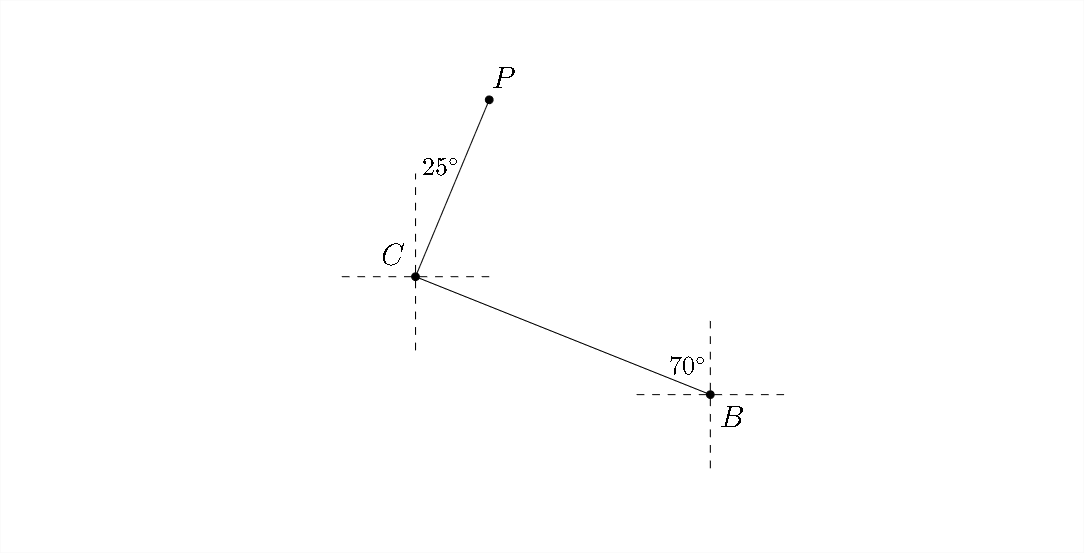
a) Based on this information, find the air distance between Portland and Bend.
b) Find the bearing from Portland to Bend.
Solution
In this problem, a diagram has been given. We'll amend this to make it into a triangle:
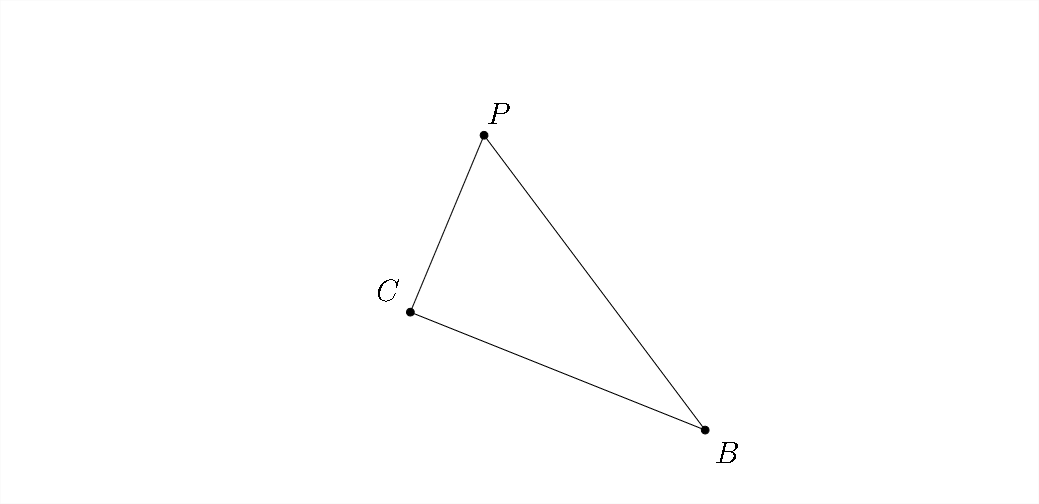
Filling the measures of the angles is tricky in this problem, so let's look at the original diagram again:
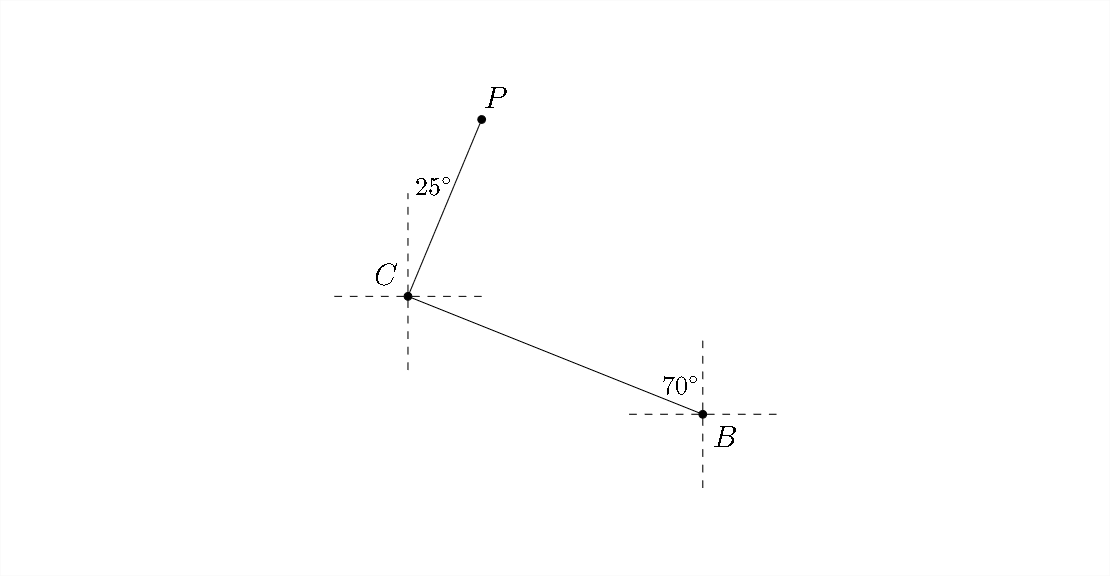
If we extend the dashed line east from Corvallis so that it meets the dashed line
running north from Bend, we can create a triangle that shows us that the angle \(\angle B C X=20^{\circ} .\) Also, notice that \(\angle P C X=\left(90^{\circ}-25^{\circ}\right)=65^{\circ}\)
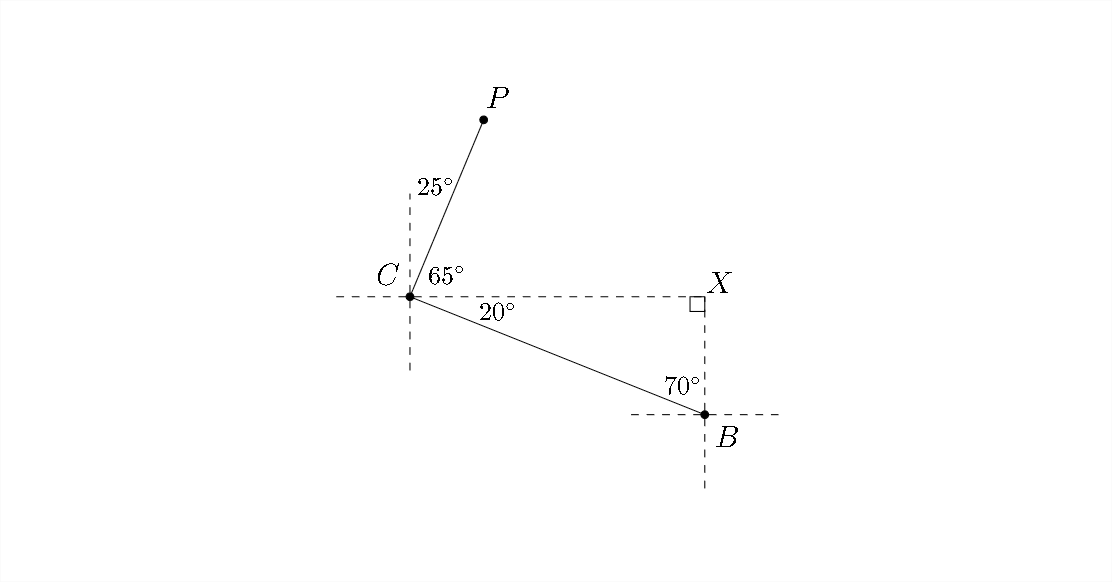
This means that \(\angle B C P=85^{\circ} .\) We know from the problem that \(\overline{B C}=103\) and \(\overline{C P}=72 .\) We'll need to find the length of \(\overline{B P}\) and the measure of \(\angle C P B\) to answer the questions.
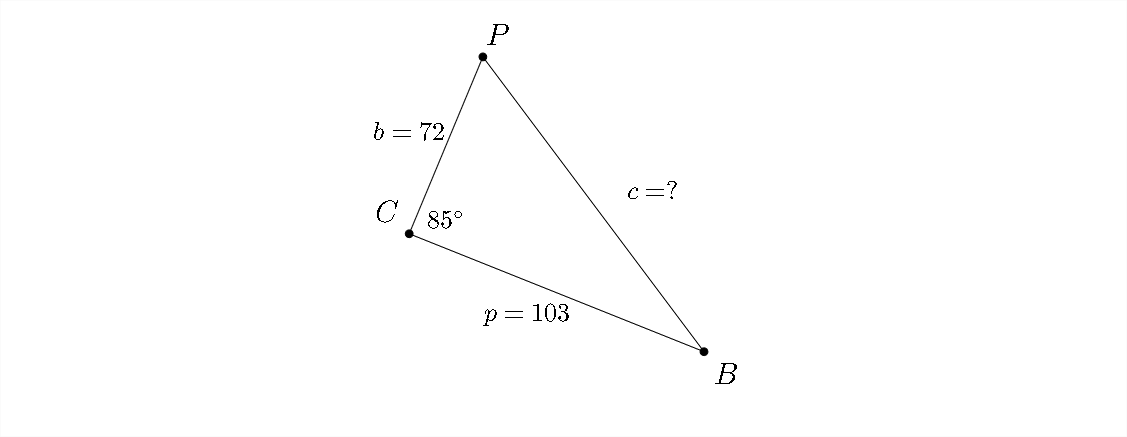
Now we're working with a triangle like the one pictured above, so we can use the Law of cosines to find the air distance from Portland to Bend:
\[
\begin{array}{c}
c^{2}=b^{2}+p^{2}-2 b p \cos C \\
c^{2}=72^{2}+103^{2}-2 * 72 * 103 * \cos 85^{\circ} \\
c^{2} \approx 5184+10,609-14,832 *(0.087156) \\
c^{2} \approx 15,793-1292.7 \\
c^{2} \approx 14,500.3 \\
c \approx 120.4 \text { miles }
\end{array}
\]
To find \(\angle P,\) we'll use the Law of sines:
\[
\begin{array}{c}
\frac{\sin 85^{\circ}}{120.4}=\frac{\sin P}{103} \\
103 * \frac{\sin 85^{\circ}}{120.4}=\sin P \\
103 * \frac{0.9962}{120.4} \approx \sin P \\
0.85223 \approx \sin P \\
58.4^{\circ} \approx P
\end{array}
\]
Now that we know the measure of \(\angle P\), we can determine the bearing of Bend from Portland.
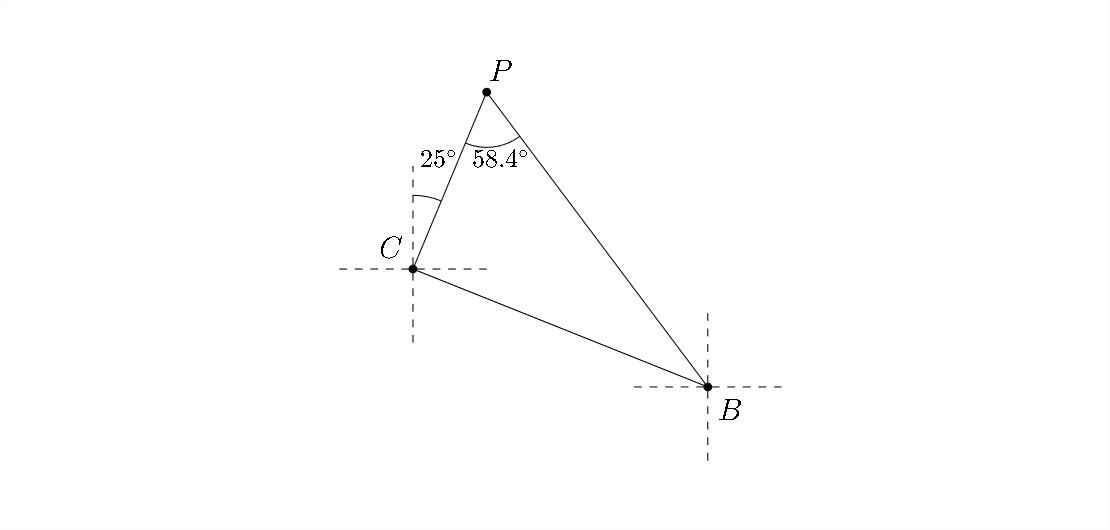
In the picture below notice that \(\angle Y P C=25^{\circ} .\) This means that the bearing from Portland to Bend will be east of south by the difference between \(\angle P=58.4^{\circ}\) and \(\angle Y P C=25^{\circ} .\) This makes the bearing of Bend from Portland equal to \(S 33.4^{\circ} E\)

Example \(\PageIndex{4}\)
A 125 foot tower is located on the side of a mountain that is inclined \(32^{\circ}\) to the horizontal. A guy wire is to be attached to the top of the tower and anchored at a point 55 feet downhill from the base of the tower. Find the shortest length of wire needed.
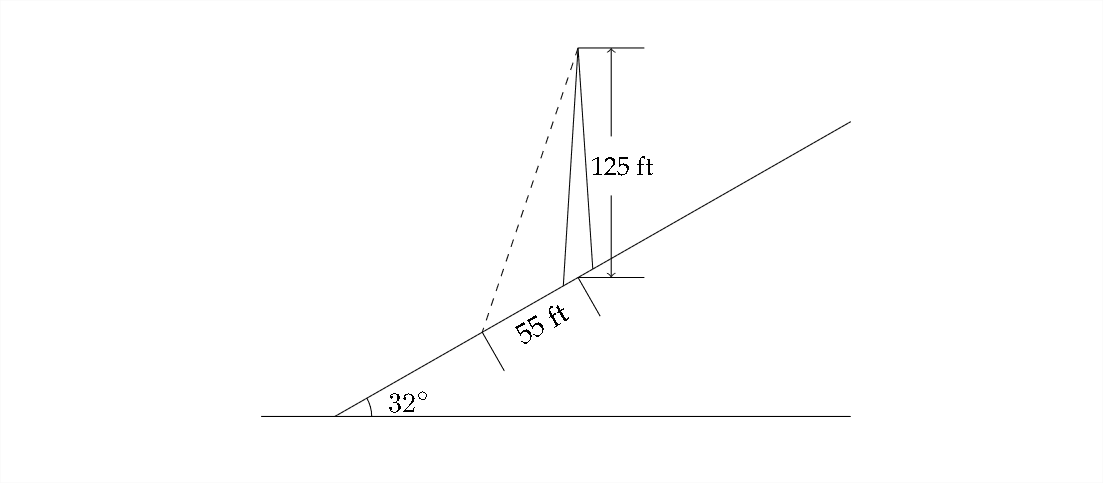
Solution
An important aspect in solving this problem is to identify a triangle in the problem which involves the unknown quantity we're being asked to find. If we're looking for the length of the guy wire, we can use a triangle that involves the wire, the distance from the wire to the center of the tower and the height of the tower:

The angle between the horizontal and the hill will stay \(32^{\circ}\) at any point on the hill. If we drop a perpendicular to the horizontal, we'll be able to find the angle included between the two given sides.
In the little right triangle, we know the 32 'angle. That means the other acute angle must be \(58^{\circ}\), and the supplementary angle (which is in the triangle we're interested in \()\) will be \(122^{\circ}\)

Now we can use the Law of cosines to find the length of the guy wire:
\[
\begin{array}{c}
x^{2}=125^{2}+55^{2}-2 * 125 * 55 * \cos 122^{\circ} \\
x^{2}=15,625+3025-13,750 * \cos 122^{\circ} \\
x^{2} \approx 18,650+7286.39 \\
x^{2} \approx 25,936.39 \\
x \approx 161 \text { feet }
\end{array}
\]
Exercises
1. Two straight roads diverge at an angle of \(50^{\circ}\). Two cars leave the intersection at \(1 \mathrm{pm},\) one traveling \(60 \mathrm{mph}\) and the other traveling \(45 \mathrm{mph}\). How far apart are the cars (as the crow flies) at \(1: 30 \mathrm{pm} ?\)
2. Two boats leave the same port at the same time. One travels at a speed of
\(40 \mathrm{mph}\) in the direction \(N 30^{\circ} E\) and the other travels at a speed of 28 mph in the direction \(S 75^{\circ} E .\) How far apart are the two boats after one hour?
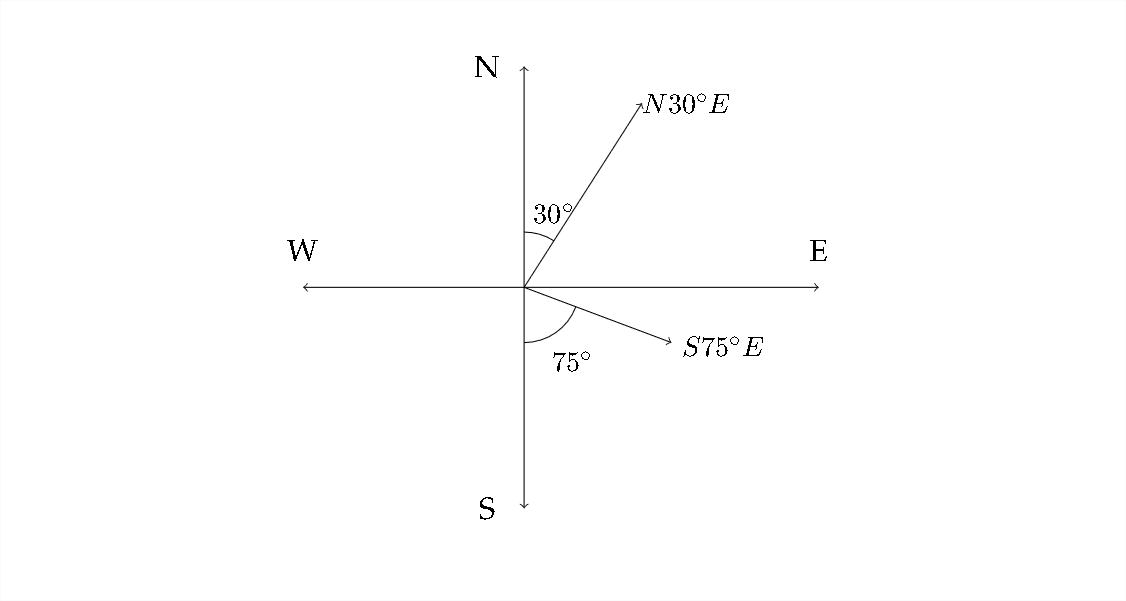
3. The airport in Desert Junction is 350 miles from the airport in Valley Center at a bearing of \(N 57^{\circ} E .\) A pilot who wants to fly from Valley Center to Desert Junction mistakenly flies due east at 225 mph for 30 minutes before correcting the error. How far is the plane from its destination when the pilot notices the error? What bearing should the plane use in order to arrive at Desert Junction?

4. An airplane leaves airport \(A\) and travels 520 miles to airport \(B\) at a bearing of \(N 35^{\circ} W .\) The plane leaves airport \(B\) and travels to airport \(C 310\) miles away at a bearing of \(S 65^{\circ} W\) from airport \(B .\) Find the distance from airport \(A\) to airport \(C .\)
5. Two planes take off at the same time from an airport. The first plane flies at 300 mph at a bearing of \(S 45^{\circ} E .\) The second plane is flying at a bearing of \(S 5^{\circ} W\) with a speed of 330 mph. How far apart are they after 3 hours?
6. Two planes leave an airport at the same time. Their speeds are \(180 \mathrm{mph}\) and \(110 \mathrm{mph},\) and the angle between their flight paths is \(43^{\circ} .\) How far apart are they after 2.5 hours?
7. Two ships leave a harbor entrance at the same time. The first travels at a speed of 23 mph and the second travels at 17 mph. If the angle between the courses of the ships is \(110^{\circ},\) how far apart are they after one hour?
8. A ship leaves the entrance to a harbor and travels 15 miles with a bear\(\operatorname{ing} S 10^{\circ} W,\) then turns and travels 45 miles with a bearing of \(N 43^{\circ} W .\) How far from the harbor entrance is the ship and what is the bearing of the ship from the harbor?
9. A steep mountain is inclined \(77^{\circ}\) to the horizontal and rises 3000 feet above the surrounding plain. A cable car is to be installed that will connect the plain to the top of the mountain. The distance from the foot of the mountain to the cable car entry loading area is 1200 feet (see diagram below). Find the shortest necessary length of the cable.
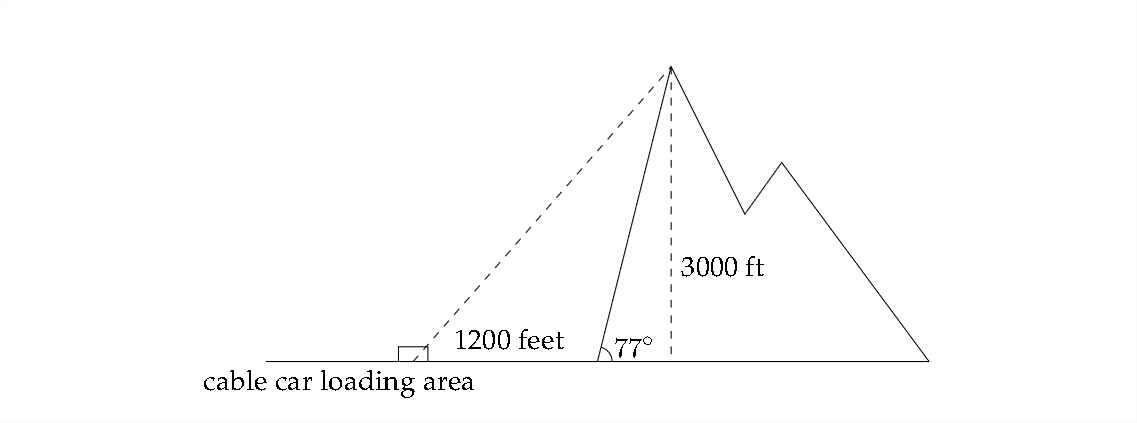
10. A tree on a hillside casts a shadow \(208 \mathrm{ft}\) down the hill. If the angle of inclination of the hillside is \(25^{\circ}\) to the horizontal and the angle of elevation of the \(\operatorname{sun}\) is \(51^{\circ},\) find the height of the tree.



